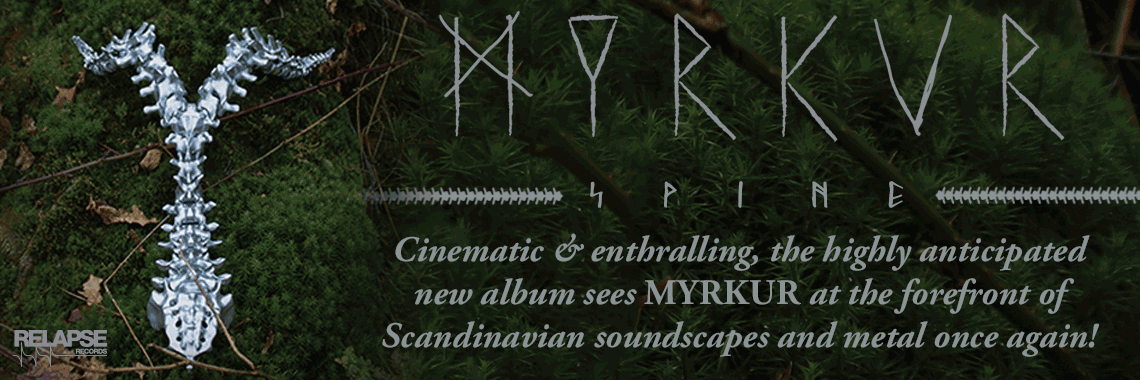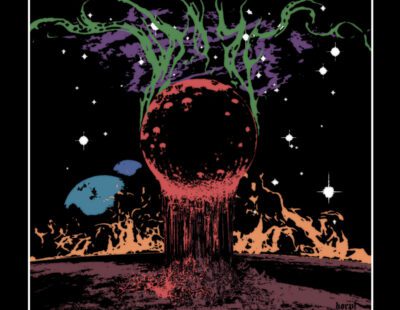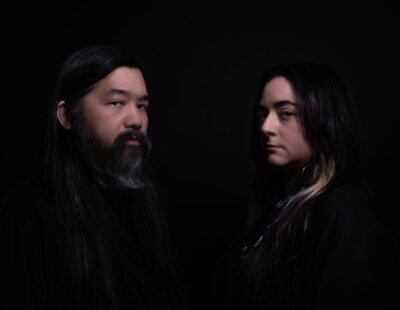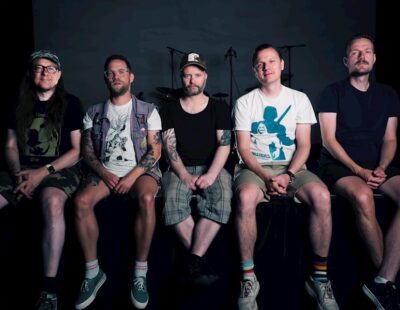
You may have noticed that Neurosis recently got a whole issue of our mag dedicated to them in honor of their three full decades spent pursuing a powerful vision of music (and beyond) that’s extreme in every sense of the word, with near-religious dedication. So let’s talk about them in gross Internet media-speak: Man, they really generate a lot of content! A triple Hall of Fame induction, an outstanding cover story on their upcoming LP Fires Within Fires, dudes from Converge and Eyehategod lining up to give testimonials…. We are fuckin’ bloated to bursting with Neurosis right now if you really want to know. Matt Solis’ HOF entry on Times of Grace also gave us a closer look at its experimental companion piece Grace for this blog. For my part I got to interview all of the artists who created Neurosis’ live visuals over the years and, really, performed them as band members: Adam Kendall, Pete Inc. and Josh Graham, along with Steve Von Till. This was seriously one of the coolest assignments I’ve ever gotten. And even that generated more material than we could use in the issue, so here’s some more!
Steve Von Till, guitar and vocals
Neurosis draws from genres like hardcore punk and post-punk where there were a lot of bands with instantly recognizable logos or strong visual identities. Which ones did Neurosis admire most?
Crass was a very important band visually, from their iconic logo to the continuity of their design aesthetic with all their albums, the fucked up collages on their massive foldout album covers and the fact that they also had their own art-damaged film collages at some of their performances. Rudimentary Peni as well, with the mind-bending outsider art of Nick Blinko. Swans also had a great simple but powerful visual element. Black Flag with their bars image and the art of Raymond Pettibon.
What visual artists, filmmakers, etc., were you all into in the early days?
Survival Research Laboratories with their poster art, and the danger and lawlessness of their machines, were definitely inspiring in our area. The Church of the Subgenius with their collage art, and I believe Amok Books put out a video collage that we admired as well. [Nerd’s note from AB: Amok Assault Video.] There were a lot of underground art-damaged events in the warehouse scene that often interacted with punk shows at DIY spaces. We would borrow imagery from any old art films we could find and discovered a lot in this process. We stole a ton from Maya Deren, Man Ray, Fritz Lang and the early film avant garde. We also lifted from films like [Stan] Brakhage’s Dog Star Man, [Alejandro] Jodorowsky’s Holy Mountain, Kenneth Anger’s Lucifer Rising. Ken Russell’s Altered States was in some ways the ultimate. Cutting and looping pieces of these between our own images, occult and primal symbols, documentaries, war footage, animal experimentation films and beautiful colorful mandalas, fractals etc., was all pretty unsettling.
What did each of the artists who did live visuals bring to the band, in your opinion?
Adam Kendall was the first one to have the courage to dive in and help us figure it out. He also loved the underground avant garde films, imagery from mythology and the occult and had his own artistic sensibility which really shaped our first primitive efforts to become the complete sensory overload we dreamed of. He helped us build the initial setup, collect and compile imagery and was the first to travel with us, taking this out across the U.S. and Europe.
I should add that Simon [McIlroy], our keyboardist for Souls at Zero and Enemy of the Sun, also began contributing to developing our visuals at this point. He did psychedelic visuals with a similar setup for underground raves, and while the imagery was completely different, we interacted with other veteran visual artists which allowed us to borrow and steal techniques that were helpful.
Pete Inc. took it to the next level as we were becoming a relentless road machine. He refined the equipment and the setup and expanded upon the old ideas. He was definitely a psychonaut and an artist in his own right and took the hypnotic nature to new heights and depths.
Josh Graham brought us into the modern age. We made the jump to video, which finally became bright and powerful enough to become a reality. It was a lot easier to travel with a video setup than all the heavy projectors and media. Josh was very talented in both the technical and artistic aspects of design and video. It was a cleaner, more precise way to use imagery. We veered away from media theft and collage and more into creating our own more natural and elemental landscapes. Josh also helped us rein in all the various elements of our design from the album art, to the merch designs, to the live visuals and tie them all together into a cohesive unit.
Adam Kendall, visuals 1990-1993
What kind of gear were you using to assemble and project the visuals in the early days? Was it a pretty low-tech setup?
Absolutely DIY. Simon and I had a mutual interest in doing visuals for underground raves, and it was from this particular scene—which had an unmistakable influence from ‘60s visual artists—that we built the kit. In fact, little about the setup has changed since the ‘60s: foam core strobe wheels mounted onto upright-mounted cake mixers and controlled by a dimmer switch; color wheels made from a bike wheel and controlled by hand; gels, film loops, homemade films; curated images re-photographed onto slide film; stacks of Kodak slide projectors; and a couple Bell and Howell 16mm film projectors. With this combination of gear, I would alter the film and slides’ timing, along with the strobe and color wheels, by hand like a musical instrument. I remember some people—some who may have been originally perplexed as to why a film guy was a full member of the band—watch with a trancelike gaze as I played the equipment with the same skill and agility as any of those who were on the stage. I think it really changed a lot of minds as to what a live performance could be—at least in that particular scene, since what I was doing was certainly not new!

Pete Inc., visuals 1993-2000
What was the first Neurosis show you ever saw?
I’m not sure exactly when I saw Neurosis for the first time. I was in southern Utah at reform school when the band formed in 1985, and spent most of 1986 up to no good in Salt Lake City. I first saw Neurosis shortly after I returned to Berkeley/Oakland. Could have been at a house party or a backyard BBQ. Might have been at Gilman St. I really can’t remember. Sometime between Pain of Mind and The Word as Law.
When you took over visuals from Adam, what kind of personal spin did you put on them?
When I took over for Adam I got his light show lock, stock and barrel. I got his whole physical setup and all of his images. It took me a while just to get the hang of things. My first show was in Santa Cruz in a little club way up in the hills. I was set up on Adam’s folding tables basically in the middle of the pit and about one minute into the set a big clump of skinheads crashed into me and knocked over everything. I distinctly remember the film moving up to the ceiling and getting really small as the projectors fell backwards on top of me. Trial by fire, I suppose.
Adam’s light show was really violent. It was awesome, an all-out assault on the senses. As I started to make the light show my own I added slides and film as they were created so things morphed slowly.
Psychedelia is a powerful thing when you pair it with music. The sound and sights feed off one another. I played my lights like they were an instrument. I had a setlist. There were certain parts to go with certain songs. I did my best to match the music dynamically, with slow lulling parts during the buildup and visual explosives when the heaviness kicked in. Over time I would say the main change was more subtlety. People feel awful when you show them a loop of someone committing suicide and I loved to do that to the crowd. Mushroom clouds in Japan, concentration camp footage in Germany… dirty pool but really fun. Later I found it was much more satisfying to affect people in a way they couldn’t put their finger on. If you can make someone feel awful and they have no idea why, you’re onto something.
During your time with Neurosis they signed to Relapse, released two of the three albums we’re inducting into our Hall of Fame (Through Silver in Blood and Times of Grace) and played Ozzfest. How did the visual identity of the band evolve over this period?
What really changed during that time was the sheer volume of touring. We were a touring machine. We played about 250 shows in 1997. It wasn’t tour for two or three weeks and then go home, it was tour all the time and go home for two or three weeks. We did one tour in Europe with 69 shows in 74 days. There was a 21-day stretch with shows every day.
In the states we did all our own driving. The distances in America are huge. You can pack up, drive all night and still be late for load in the next day.
We grew a lot as a band during that time. We did our first “big” tour opening for Gwar. I had to break down my gear at lightning speed before it got covered in fake blood. We opened for Pantera and played a lot of minor league hockey stadiums. I had to rent a special 16mm projector with a xenon arc bulb because I was so far away from the screen. I never had any power problems on that tour; extension cords would just get lowered out of the rafters like magic.
We had it down. Once you’ve been out for a couple weeks everything starts to gel. Everybody knows what to do and when to do it. You get into a rhythm and everything is clicking. It’s a great feeling to pull into a city, destroy it with precision and then do it all over the next day. We were cavemen from the future. Good/hard times.
How did the equipment setup for the visuals evolve over your time with the band?
Since I came into the light show as a roadie and had all the equipment knocked over onto me immediately, my first order of business was to get the gear tour-ready. There’s a physical aspect to doing live projections that is crucial even though nobody really thinks about it. First of all, you have to get over everybody’s heads. I converted a 7-foot tall 4×4 warehouse shelf to hold all the gear. It broke down well and fit in the van in nice neat bundles of parts duct taped together.
The slide projectors used to ride loose but Simon designed a box that held all six projectors for travel and let me stack them three high and two wide during the set. I had one more box to hold the rest of my stuff and I was ready to roll.
Dave and I lived up the street from a ‘60s light show guru who did visuals for Jefferson Airplane and Big Brother and the Holding Company. He was one of the first people to do analog lights in the world. He helped me hot-rod my projectors with special bulb housings and higher gears for the fans so I could use brighter bulbs, longer lenses so I could shoot from further away, and glass mounts for the slides so they wouldn’t melt in the heat.
There are a lot of other considerations to take into account when doing lights live. Where am I going to build my shelf? There is no “safe spot” in most clubs to build a tower with a bunch of projectors on top. Is there a balcony? Are there hanging speakers in the way? Am I blocking an evacuation route? I went head to head with club managers almost every day. They just weren’t prepared for me. How do I get light on the band and keep it off of the screen at the same time? While the band was setting up I was on a mission to block stray light, taping cardboard over exit signs and unplugging all the neon lights at the bar. it was also a real challenge to get the local light guy to just leave everything alone during the set. They get such itchy fingers. Where am I going to get power? I carried 300 feet of extension cords. We blew so many fuses! The band was already blowing fuses on their end of the room before I even plugged in. Sixty amps is a lot to ask. When clubs didn’t take me seriously about getting good power I would always plug in by the bar; people sit up and take notice when you knock out power to their cash register. How do I keep the crowd off my stuff? Without the sanctity of the stage, people felt free to set their beers down right next to my power strips. They would lean on my shelf and make the visuals wiggle all over the place. I started off with polite signs like “Please don’t put your drinks here” and “High voltage, danger!” But the target audience doesn’t care about all that so my signs devolved into “NO TOUCH!” It was much more effective. I also had a bright orange rubber mallet to threaten people with if things started to get out of hand.
To read the rest of the Neurosis issue, you can purchase the digital edition here.







